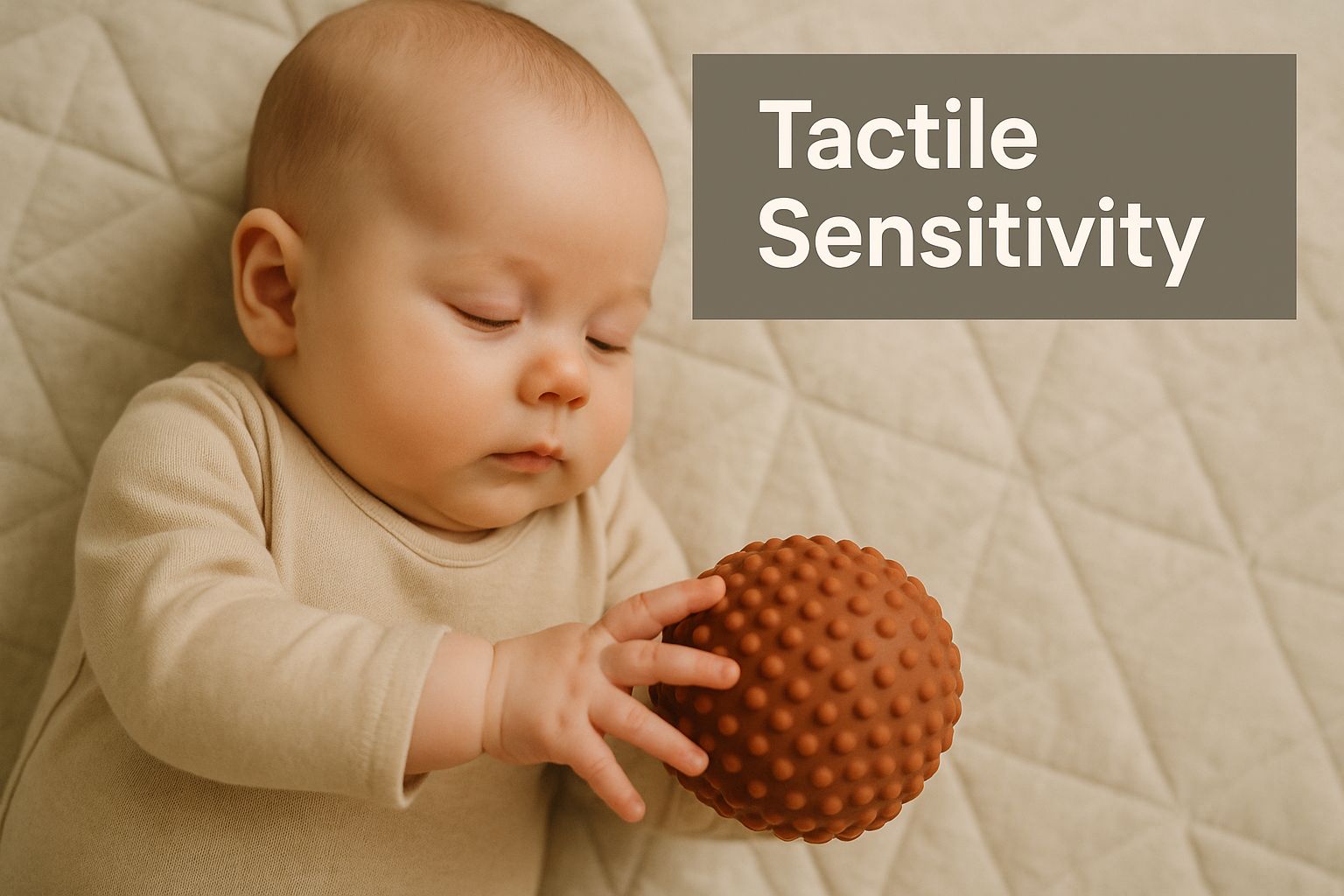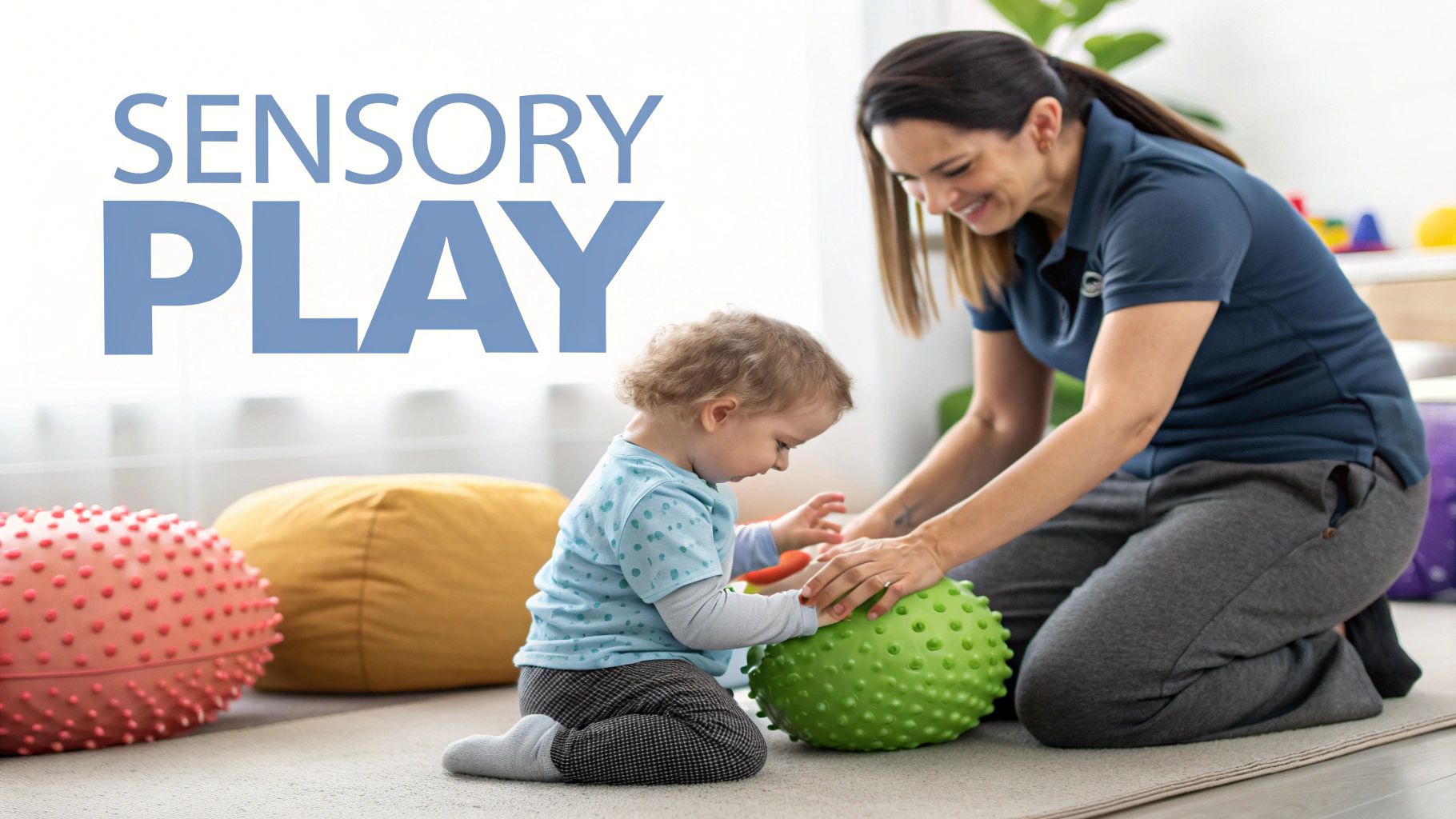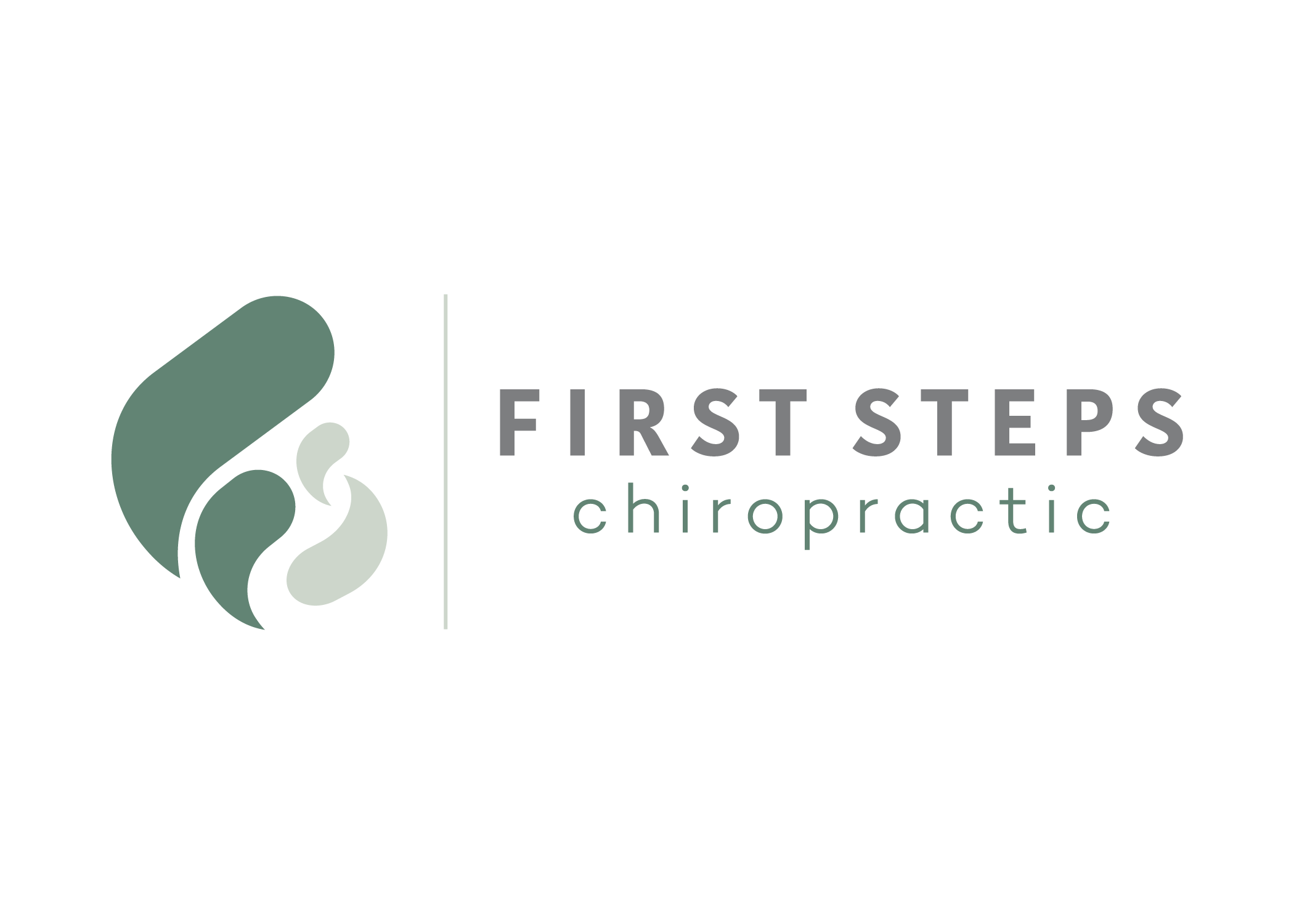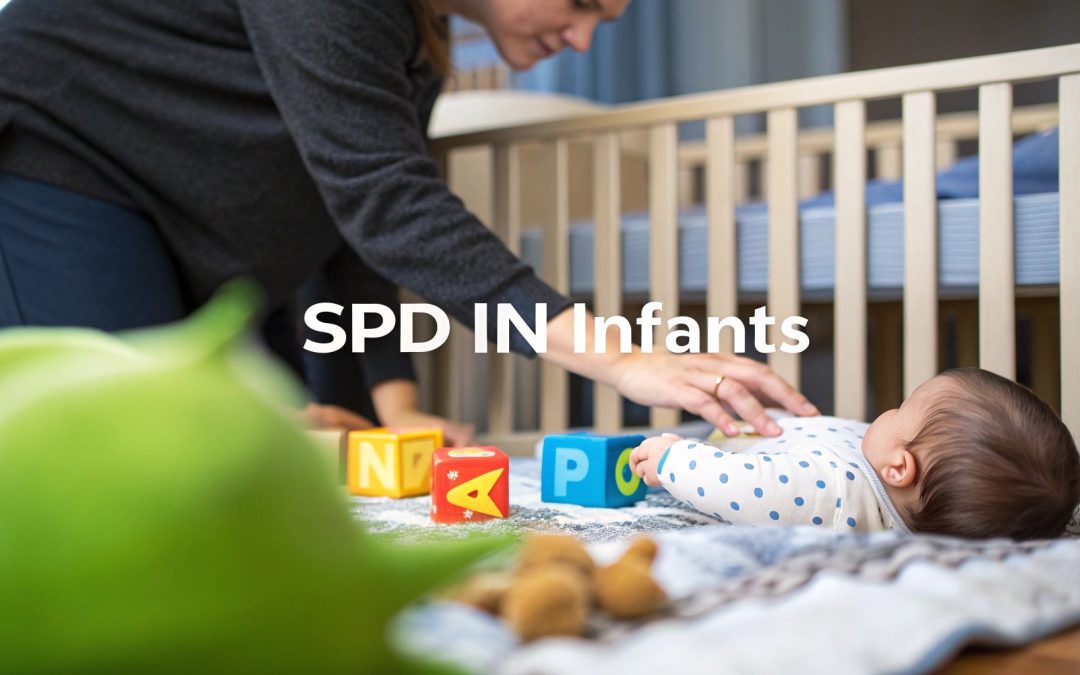Sensory Processing Disorder (SPD) is a neurological condition that messes with how an infant's brain takes in and responds to information from their senses. Imagine a busy intersection where the traffic lights are all out of sync—that's kind of what's happening inside their nervous system.
When sensory signals get jumbled, it can lead to some really puzzling reactions to everyday touch, sounds, or movements. It's crucial to understand this is a developmental challenge, not a behavioral problem or a reflection on your parenting.
Decoding Your Infant’s Sensory World
For a newborn, the world is a non-stop flood of new information. Every single sight, sound, and touch is a signal their tiny, developing nervous system has to figure out and organize. For most babies, this happens pretty automatically, laying the groundwork for how they learn to interact with everything around them.
But for an infant with SPD, this internal communication system feels more like chaos. You could think of their nervous system as a brand-new traffic control center where the team is still learning how to manage all the signals. Sometimes, way too many signals come in at once, causing a sensory "traffic jam." Other times, the signals aren't strong enough to even get noticed.
This isn't your baby being "fussy" or "difficult." It's their brain genuinely struggling to make sense of the world.
What Does a Sensory Traffic Jam Look Like?
This neurological disorganization usually shows up in one of two ways. Some infants are hypersensitive, or over-responsive, meaning even the gentlest sensory input feels completely overwhelming. On the flip side, others are hyposensitive, or under-responsive, and they need much more intense stimulation just to register that something is happening.
A baby's reactions can be shaped by a lot of different things, so it’s important to look at the big picture of their health. While SPD is neurological, other conditions can also affect an infant’s motor skills and responses. For example, the global prevalence of certain genetic conditions, like Spinal Muscular Atrophy, averages around 8 children per 100,000 births, though this can vary. Understanding these different possibilities highlights why a thorough assessment is so important for getting to the real root cause of your child's challenges. You can read more about SMA prevalence from the latest research on Rare Disease Advisor.
An infant’s nervous system is built to process billions of bits of information every single second. When this system gets stressed or disorganized, it can throw off their ability to eat, sleep, and calm themselves down, impacting their development across the board.
Getting a handle on the core ideas behind SPD is the first step toward finding the right support. You can dive deeper by reading our detailed guide on what Sensory Processing Disorder truly is. Once you recognize that these behaviors are coming from a neurological challenge, it empowers you to respond with empathy and find effective, supportive solutions.
Identifying Early Signs of Infant SPD
You know your baby better than anyone else. That instinct you feel? It’s your most powerful tool. When we talk about Sensory Processing Disorder (SPD in infants), the early signs are often quiet and easily brushed off as just "fussy" behavior. The real key is to look for consistent patterns in how your little one engages with the world.
Most of these early signs fall into two main camps: hypersensitivity (over-responsiveness) and hyposensitivity (under-responsiveness). Imagine their sensory system has a volume dial. A hypersensitive baby’s dial is cranked way up, making everyday sights, sounds, and touches feel incredibly intense. On the flip side, a hyposensitive baby’s dial is turned way down, meaning they need much more sensory input just to register that something is happening.
To make things even more interesting, an infant can show signs from just one category or a confusing mix of both. For instance, they might be terrified of loud noises but constantly crave the feeling of deep pressure, like a tight hug. Learning to spot these patterns is the first step in understanding what your baby is truly experiencing.
Over-Responsive Infant Behaviors
Hypersensitivity is usually what parents notice first because it often leads to a distressed, crying baby. An over-responsive infant's nervous system is essentially on high alert 24/7, reacting in a big way to what seems like minor sensory information. To them, the world can feel painfully loud, bright, and chaotic.
Common signs of an over-responsive baby include:
- Extreme reactions to touch: They might fight being swaddled, despise certain clothing fabrics, or scream during bath time and diaper changes.
- Aversion to sounds: Normal household noises—the vacuum, a blender, even a flushing toilet—can trigger significant distress.
- Visual sensitivity: They might get easily overwhelmed in brightly lit stores or seem startled by quick movements in their field of vision.
- Feeding difficulties: Some babies will gag on or completely refuse certain food textures. They might also struggle with the sensation of a bottle or nipple in their mouth.
When you see these behaviors, it’s a signal that their nervous system is totally overloaded. They aren't being defiant; they are in a genuine state of sensory crisis.
This infographic gives a great visual for one of the most common sensory challenges parents notice—sensitivity to touch.

For a baby with tactile hypersensitivity, the feeling of a simple clothing tag isn't just annoying; it can be genuinely painful and distressing.
Under-Responsive Infant Behaviors
Hyposensitivity can be much harder to spot because these babies often come across as "too easy" or a bit disconnected. An under-responsive baby’s nervous system is asking for more—more noise, more movement, more pressure—just to register the world around them. While they might be labeled "easy" babies, they could be missing out on the sensory building blocks crucial for development.
Signs of an under-responsive baby include:
- Appearing indifferent to stimuli: They may barely react to a little bump or scrape and might seem unusually calm in very loud places.
- Constant need for movement: These are the babies who crave motion. They love being bounced or swung vigorously and can seem almost restless.
- "Floppy" muscle tone: They might feel a bit limp when you pick them up or have a harder time holding their head steady.
- Delayed motor skills: Because their brain isn't getting strong sensory signals, they may be slower to hit milestones like rolling over, crawling, or sitting up.
This constant search for sensation is the brain's attempt to get the feedback it needs. The infant isn't trying to be difficult; their nervous system is simply trying to wake itself up.
To help you see the difference more clearly, we've put together a table that breaks down these opposite behaviors.
Hypersensitive vs. Hyposensitive Traits in Infants
This chart compares common over-responsive (hypersensitive) and under-responsive (hyposensitive) behaviors. It’s a great tool to help you start identifying your infant's unique sensory patterns.
| Sensory Input | Hypersensitive (Over-Responsive) Signs | Hyposensitive (Under-Responsive) Signs |
|---|---|---|
| Touch | Hates cuddles, certain clothes, or messy play. Cries during bath time. | Craves deep pressure, loves tight swaddles, and mouths or chews on objects constantly. |
| Movement | Fears being tilted back (e.g., during diaper changes) and dislikes swings. | Loves being bounced, swung, or rocked intensely. Constantly in motion. |
| Sound | Startles easily at loud or unexpected noises. Covers ears or cries in noisy places. | Seems to ignore loud sounds. May not respond when their name is called. |
| Sight | Avoids eye contact and is easily overwhelmed by bright lights or busy patterns. | Is fascinated by bright, flashy toys and screens. May stare intently at objects. |
Remember, no two children are the same, and your baby may show a mix of these traits. Observing and understanding their specific needs is the first, most important step.
What Causes Sensory Processing Challenges?
When you’re a parent trying to understand why your infant is struggling, it’s easy to look for a single, straightforward answer. But when it comes to SPD in infants, the truth is that it rarely comes from just one thing.
Sensory processing challenges are almost always the result of a complex mix of factors—genetics, what happens during pregnancy, and the birthing process itself. The goal isn't to find blame, but to see how all these pieces fit together to shape your child's developing nervous system.
We know there’s a genetic component, which means a tendency for sensory issues can run in families. While the science is still catching up on the exact "how," it’s clear that a baby's built-in neurological wiring plays a huge part in how they handle the world from day one.
How Pregnancy and Birth Shape the Nervous System
The journey from the womb into the world is one of the most intense physical events a person ever goes through. It's a critical time that lays the foundation for how the nervous system will function for the rest of their life. Several things during this period can increase the odds of sensory processing difficulties.
- Premature Birth: Babies who arrive early haven't had the full time to develop their nervous system in the quiet, controlled world of the womb. This can make the sensory flood of the outside world especially jarring for them.
- A Tough Delivery: A long, difficult labor can be incredibly stressful for a baby. Interventions like forceps, vacuum extraction, or even an emergency C-section put a massive amount of physical strain on their tiny neck and spine.
- Stuck In Utero: If a baby was in a position like breech, their movement was restricted before they were even born. This can interfere with the development of their proprioceptive system, which is their internal sense of body awareness.
This kind of physical stress isn't just a fleeting moment of discomfort. It can lead to subtle misalignments in the upper neck, creating what we call "static" or interference in the nervous system.
This interference gets in the way of the brain's ability to properly receive, understand, and react to sensory signals. It's often this disruption that leads to the disorganized, overwhelming responses we see in SPD in infants.
The birthing process, even a smooth one, can be a major physical event for an infant’s nervous system. The forces involved can create underlying stress that directly impacts how a baby learns to process and adapt to their new sensory world.
Understanding this link is crucial because it shows just how much early life events can shape a child's neurology. And while sensory challenges are neurological, it's also important to know about other conditions that might affect a baby's physical responses.
For instance, Spinal Muscular Atrophy (SMA) is a genetic condition that causes muscle weakness and is found in about 1 in every 14,694 newborns in the United States. Being aware of the full range of possibilities helps parents find the right support for their child. You can learn more about these SMA statistics from SpinalMuscularAtrophy.net.
When we look at these risk factors, we get a much clearer picture of why an infant’s nervous system might be overstressed and struggling. It also helps explain why gentle, targeted interventions can be so effective at easing that system-wide tension and getting the brain and body communicating clearly again.
How the Nervous System Manages Sensory Information
To really wrap our heads around how we can help babies with SPD, we first need a quick look under the hood at the body’s "central command center"—the nervous system. It's best to think of it as a super-advanced communication network. The brain is the main hub, the spinal cord is the super-highway for information, and countless nerves branch out, connecting every single part of the body.
This whole network is built for a constant, two-way conversation. When your baby feels the fuzzy texture of their favorite blanket or hears the familiar sound of your voice, sensory receptors fire off signals. Those signals shoot up the spinal cord highway straight to the brain. In a split second, the brain deciphers the message and sends a response back down, telling the body how to react—maybe to snuggle deeper into the blanket or turn their head toward you.

This entire process is lightning-fast. For an infant with a well-regulated nervous system, this communication is smooth and seamless, helping them make sense of their world and respond appropriately.
When Communication Lines Get Crossed
So, what happens if there’s some interference in this amazing network? The journey into the world can be tough. Physical stress from birth trauma or even just being stuck in a cramped position in the womb can cause tiny misalignments in a baby's delicate spine, especially up in the neck. In the world of chiropractic, we call this a subluxation.
A subluxation is like having static on a phone line or a really weak Wi-Fi signal. It messes with the clear transmission of information between the body and the brain, creating what we call neurological disorganization. This "static" can completely distort the sensory messages the brain is trying to read.
A gentle, loving touch might feel painful. A normal, everyday sound might seem terrifyingly loud. The simple sensation of being rocked could feel completely overwhelming. This interference is so often a key piece of the puzzle behind the disorganized sensory responses we see in infants with SPD.
When the nervous system gets stuck in this stressed-out, frazzled state, the brain simply can’t process sensory input the way it’s supposed to. This leads directly to the over- or under-reactions that have parents feeling so concerned. Understanding this crucial link is the first step toward getting your child the effective support they need. To dive deeper into how this works, check out our guide on nervous system regulation.
This is exactly why a pediatric chiropractic evaluation is so foundational. By assessing the function of this critical communication network, we can pinpoint where the interference might be happening. The goal is simple: clear the static so the brain and body can finally get back to communicating clearly and effectively.
What to Expect During a Chiropractic Assessment

The thought of taking your baby to a chiropractor might feel a little nerve-wracking, but I want to assure you—the reality is a calm, gentle, and reassuring experience. A pediatric chiropractic evaluation is specifically designed for an infant's tiny, delicate system. We use non-invasive techniques that put their comfort and safety above everything else. The goal is to figure out how their nervous system is working, not to cause any stress.
The visit always starts with a conversation. I'll sit down with you and listen carefully as you share your observations—all the little behaviors, challenges, and milestones you've noticed. This history is a huge piece of the puzzle, giving us invaluable insight into your baby's unique sensory world. After that, the hands-on part begins, which is incredibly gentle and involves more observation than anything.
A Gentle and Thorough Examination
First, the chiropractor will simply observe your baby's posture, muscle tone, and how they move on their own. We're trained to spot subtle imbalances or areas of tension that can signal underlying stress in the nervous system. This isn't about forceful manipulation; it’s about using a light touch and gentle motion to feel how your baby’s spine and joints are moving.
A key part of the exam is checking their primitive reflexes. These are the involuntary movements that are absolutely essential for a baby's early development.
- Moro (Startle) Reflex: We’ll check how your baby responds to a sudden, slight drop of their head.
- Rooting Reflex: We’ll observe if they turn their head and open their mouth when their cheek is gently stroked.
- Asymmetrical Tonic Neck Reflex (ATNR): We’ll see if their arm and leg extend on the side they are looking toward.
The presence, absence, or lopsidedness of these reflexes gives us a window into your infant's neurological organization. When these reflexes are retained or underdeveloped, it can be a sign that the nervous system is struggling to process sensory information efficiently—a common finding with SPD in infants.
The entire assessment is tailored to your baby's needs and tolerance. The pressure we use is often compared to what you’d use to check the ripeness of a tomato—it’s extremely light and specific. There is absolutely no twisting, cracking, or popping involved in an infant evaluation.
Finding the Source of Nervous System Stress
Through this gentle process, the pediatric chiropractor pieces together a complete picture of your infant's neurological function. We are looking for specific areas of spinal misalignment, or subluxations, that could be creating interference in that crucial brain-body communication pathway.
This assessment is a safe and effective way to identify the root cause of the neurological stress that may be contributing to your baby's sensory challenges. By understanding exactly where the communication breakdown is happening, we can develop a precise and gentle care plan to help restore balance, allowing your little one's nervous system to finally function at its best.
Gentle Chiropractic Care for Sensory Support
Once we’ve used a thorough assessment to pinpoint where the nervous system is stressed, the next step is all about gentle, targeted support. I’ve found that when parents hear the word “chiropractic,” their minds often jump to the forceful adjustments they’ve seen or experienced themselves. But I want to be crystal clear: pediatric chiropractic care is a completely different world. It’s incredibly gentle, precise, and designed specifically for an infant’s delicate body.
Our goal is simple and direct: to reduce interference within the nervous system. We do this by delivering a very specific and light touch to areas of the spine that aren’t moving the way they should. This helps clear up that "static" we talked about earlier, allowing the vital communication pathway between the brain and the body to work much more smoothly.
What Does an Infant Adjustment Feel Like?
An infant adjustment involves absolutely no twisting, popping, or cracking. The amount of pressure we use is remarkably light—I often tell parents it’s about the same pressure you’d use to check if a tomato is ripe. It’s just a sustained, gentle contact applied with a single fingertip.
Many babies are so comfortable during their adjustments that they sleep right through the whole thing. Others might get a little fussy at first, but then you’ll see them visibly relax as that built-up tension in their nervous system begins to release. The entire process is tailored to your baby’s comfort and needs, ensuring a safe and positive experience every time.
The purpose of a pediatric adjustment isn't to "put bones back in place." Instead, it's about introducing gentle input into the nervous system to help it reset and restore proper function. This allows the brain to process sensory information more effectively.
By improving this fundamental brain-body connection, we help the nervous system become more organized and resilient. This can be a foundational piece of a comprehensive plan for sensory processing disorder therapy.
Supporting Healthy Neurological Development
When the nervous system can communicate without all that static, an infant is much better equipped to manage and adapt to their sensory world. Restoring proper function helps their internal "traffic control center" begin to process signals in a more organized, less chaotic way. This often leads to noticeable changes in their comfort, regulation, and overall development.
For infants showing early signs of SPD, this can mean:
- Improved Regulation: A calmer, more settled baby who isn’t so easily overwhelmed by their surroundings.
- Better Feeding and Digestion: Easing tension in the neck and jaw can make a world of difference for a baby struggling with latching and digestion.
- Enhanced Motor Skills: With clearer neural pathways, babies may find it easier to meet those big developmental milestones like rolling over and crawling.
- More Restful Sleep: A less-stressed nervous system often leads to better and more restorative sleep patterns—a game-changer for the whole family.
This gentle care helps create the optimal conditions for an infant’s nervous system to mature and develop exactly as it should. By getting to the root cause of the neurological stress, we provide the foundational support that allows a child to better integrate sensory information and truly thrive.
Common Questions About SPD in Infants
When you're first exploring the possibility of SPD in infants, it's natural to have a lot of questions. We get it. Here are some clear, straightforward answers to the concerns we hear most often from parents just starting this journey.
Can a Baby Just Outgrow SPD?
This is one of the biggest questions parents ask. While it's true some minor sensory quirks can fade as a child's nervous system matures, significant SPD challenges usually don't resolve on their own.
Without that foundational support, these early difficulties can snowball, later showing up as issues with learning, behavior, and social skills. Getting help early from professionals like occupational therapists and pediatric chiropractors gives your child a solid base for healthy sensory development, addressing the root cause before it becomes a bigger hurdle.
Is Chiropractic Care Actually Safe for a Newborn?
Yes, absolutely. But there’s a big "if"—it's exceptionally safe when performed by a chiropractor who has specialized training in pediatric care. The way we work with infants is completely different from how we adjust adults.
There are no popping or cracking sounds involved. The pressure is incredibly light and specific. Think about the amount of pressure you'd use to check if a tomato is ripe—that's the level of touch we're talking about. It’s a gentle and comfortable experience for your baby.
The entire goal of pediatric chiropractic care is to gently reduce interference in the nervous system. By doing this, we help restore clear communication between the brain and the body, which is key for better regulation and sensory processing.
How Quickly Will We See Changes?
Every baby's nervous system is one-of-a-kind, so the timeline for seeing changes really varies. Some parents tell us they notice subtle improvements—like better sleep, easier feeding, or just a more comfortable baby—after only a few visits.
For other little ones, the progress is more gradual as their nervous system begins to adapt and reorganize over time. A pediatric chiropractor will map out a personalized care plan and walk you through what you can expect based on your child's specific needs. The aim is always consistent, gentle progress that supports lasting neurological function and helps your child truly thrive.
At First Steps Chiropractic, we specialize in gentle, neurologically-focused care designed to help your little one's nervous system function at its absolute best. Schedule a complimentary consultation to learn more about how we can help.

